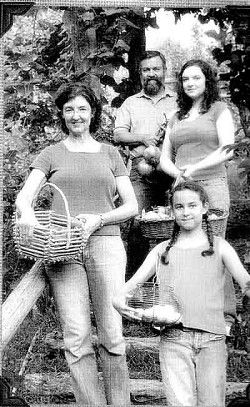From the Bookshelf: The art of living locally
Published 5:00 pm Tuesday, June 10, 2008

- Barbara Kingsolver and her family found self-reliance, challenges in living off their own land.
“Animal, Vegetable, Mineral – A Year of Food Life” by Barbara Kingsolver with Steven L. Hopp and Camille Kingsolve, 2007.
Barbara Kingsolver is a favorite author of many of us who hang out at the local library. Her collection now contains a new book, “Animal, Vegetable, Miracle – A year of Food Life,” coauthored with her spouse and oldest child. The youngest, Lily, participated enthusiastically but was too young to sign the book contract.
In spite of its title, and perhaps its subject, this has to be one of the funniest books that I have read in years. It is a book about gardening, poultry raising, cooking, eating and the economics of our food habits.
Why, with regards to the latter, for example, do we export 1.1 million potatoes and import 1.4 (and not buy from our own farmers)? Why do we eat foods laden with fats, sugar and salt, when so many of us know better and proclaim so these days in the Blue Mountain Eagle?
Maybe as we lost our farming skills, we also lost touch with reality about food. One funny (or maybe tragic?) story Steven recounts is about some city kids watching him harvest carrots. Finally one asks “How did you get them in there?” He explains patiently about growing root vegetables, starting from seeds, etc. Then asked the kids if they could give him another example of a root vegetable. They conferred for a bit then replied “… spaghetti?”
Daughter Lily, at age 8 and growing part of the family food, seems way ahead of the game. When her hens started laying, she marketed them in recycled egg cartons adorned with her photo and “Lily’s Lovely Layers.”
When she balked at donating her eggs and chickens to the family cause, her mother explained that she had provided the capital for the start of the business. Lily then calculated the start-up costs and paid her mother back, saying she didn’t just want it to be a “little kid thing.”
Lily apparently had her ears permanently tuned to her chicken coup noises and knew immediately one day when a coyote had crept into the flock. She “went screaming” for the front door. Her mother writes that she didn’t know about the coyote, but she herself nearly needed CPR.
The family butchered their own chickens and turkeys, with the small children helping. Kingsolver reports that most kids need only about 90 seconds to get from “eeeeu gross” to solid science. Some of the most entertaining (and educational) parts of the book are the family’s experience in raising of the poultry.
If “living more locally” appeals to you, you will enjoy the experiences of the family. They grew or bought locally everything they ate for a year with the exception of one luxury item each. Steven chose coffee and Barbara wrote wickedly that if he had had to choose between the family and coffee, it would have been a tough call.
They also occasionally cheated. For example, they decided that Thanksgiving without cranberries would be like “kissing through a screen door.”
“Living Locally” is catching on across the nation. Today one quarter of all households grow some of their own produce. Farmers’ markets now average about 75 per state. Our closest is Baker City.
Amazingly, small farms are actually profitable. According to USDA records from the 1990s, farms less than four acres in size had an average net income of $1,400 per acre. And the per-acre profit declines steadily as farm size grows, to less than $40 per acre. Smaller farms maximize productivity in three ways: by using each square foot of land more intensively, by growing a more diverse selection of products suitable to local food preferences, and by selling more directly to consumers, reaping more of the net earnings.
Small-farm profits are more likely to be sustained over time too, since these farmers tend to be better stewards of the land using fewer chemical inputs, causing less soil erosion, and maintaining more wildlife habitat.
Once again, this book and Kingsolver’s others are available at the Grant County Library.
Linda Driskill lives on an off-the grid homestead near the Strawberry Mountain Wilderness.






